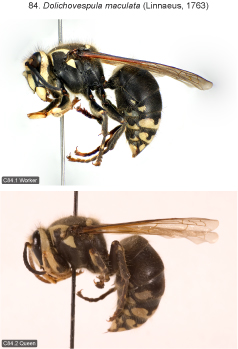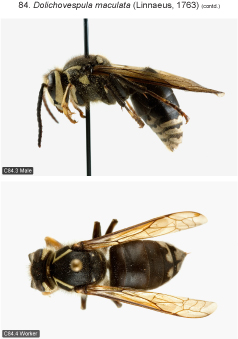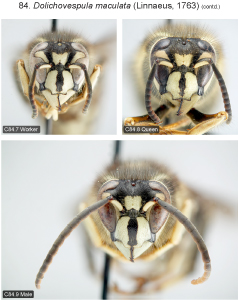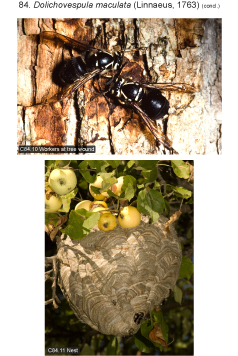
| Home | Table of contents | Keys | Species list | Glossary | Image data | PDF | Cite this article | Feedback | Updates |
Identification Atlas of the Vespidae (Hymenoptera, Aculeata) of the northeastern Nearctic region
CJAI 05, February 19, 2008
doi: 10.3752/cjai.2008.05
Matthias Buck, Stephen A. Marshall, and David K.B. Cheung
Department of Environmental Biology, University of Guelph, Guelph, Ontario, Canada N1G 2W1
Next species | Previous species | Key
84. Dolichovespula maculata (Linnaeus, 1763) – Baldfaced Hornet
Figs B12.6, 7, 13, 14; C84.1–11.
 |
 |
 |
 |
 |
Species recognition. The baldfaced hornet is the largest of our native yellowjackets. It is easily distinguished from other Dolichovespula species by the largely to completely black hind tibia (marked with pale on most or all of outer surface in other species) and other characters provided in the key.
Variation. Fore wing length 11.0 – ca. 15.0 mm (workers), ca. 15.0–18.0 mm (♀♀), 13.5–16.0 mm (♂♂); there appears to be no distinct size gap between workers and queens, which makes it difficult to separate the castes based on measurements alone. Black clypeal mark extending from dorsal margin ventrally, usually just stopping short of ventral margin, occasionally attaining it, rarely dorsally and ventrally free in female. Ivory postocular band wide, in female slightly narrowed near middle or even in width. Pronotal carina always marked with ivory; pronotum with ivory posterior band sometimes more or less broadened in female, in some cases covering nearly whole upper surface; pronotal lobes sometimes with small ivory spot in female; pronotum laterally below pronotal fovea often with small ivory spot on carina (less common in male). Metanotum sometimes lacking pair of ivory spots (more often in male than in female). Apical fascia of tergum 1 absent in female but often present and sometimes well developed in male. Tergum 3 with enclosed lateral ivory spots in female, often extending to margin of tergum in male (rarely absent); exceptionally tergum with a well-developed, medially interrupted apical fascia (1 ♂, ON, Wellington Co., Arkell, DEBU). Free black discal spots rarely present on tergum 5 or on terga 4 and 5 of female. Apical fasciae of terga 4 and 5 almost always interrupted in female, rarely only deeply incised; in male sometimes terga 4–6 only deeply incised. Hind tibia entirely black or with small ivory spot(s) near base, less often near apex as well.
Distribution. Canada: all provinces and territories except NU. U.S. except most of Great Plains, AK, south to central FL, west to eastern ND, SD, NE, KS, OK and TX, south in western mountain ranges to NM, AZ and CA (Carpenter and Kojima 1997; Akre et al. 1981).
Biology. The nests of this species are almost always aerial and usually higher above the ground than in other species (from ground level up to > 20 m). Nests are built in vegetation, on rocks and on manmade structures such as houses, sheds, power poles, etc. Exceptionally, nests may be subterranean or in hollow trees. Females prey on live arthropods, sometimes preferentially on other yellowjacket species; occasionally carrion is visited as an additional protein source. The baldfaced hornet occurs both in natural and populated areas. It usually causes relatively little nuisance because nests are often located high above the ground. The species often causes alarm due its impressive size but it actually appears to be less aggressive than some of the common smaller yellowjacket species (Akre et al. 1981).
Next species | Previous species | Key
| Home | Table of contents | Keys | Species list | Glossary | Image data | PDF | Cite this article | Feedback | Updates |
